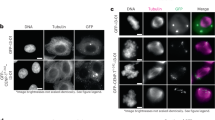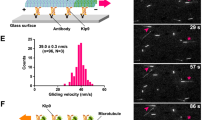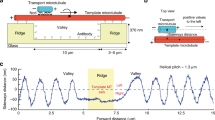Abstract
The Saccharomyces cerevisiae DASH complex is an essential microtubule-binding component of the kinetochore. We coexpressed all ten subunits of this assembly in Escherichia coli and purified a single complex, a ∼210-kDa heterodecamer with an apparent stoichiometry of one copy of each subunit. The hydrodynamic properties of the recombinant assembly are indistinguishable from those of the native complex in yeast extracts. The structure of DASH alone and bound to microtubules was visualized by EM. The free heterodecamer is relatively globular. In the presence of microtubules, DASH oligomerizes to form rings and paired helices that encircle the microtubules. We discuss potential roles for such collar-like structures in maintaining microtubule attachment and spindle integrity during chromosome segregation.
This is a preview of subscription content, access via your institution
Access options
Subscribe to this journal
Receive 12 print issues and online access
$189.00 per year
only $15.75 per issue
Buy this article
- Purchase on Springer Link
- Instant access to full article PDF
Prices may be subject to local taxes which are calculated during checkout






Similar content being viewed by others
References
McAinsh, A.D., Tytell, J.D. & Sorger, P.K. Structure, function, and regulation of budding yeast kinetochores. Annu. Rev. Cell Dev. Biol. 19, 519–539 (2003).
Hofmann, C. et al. Saccharomyces cerevisiae Duo1p and Dam1p, novel proteins involved in mitotic spindle function. J. Cell Biol. 143, 1029–1040 (1998).
Jones, M.H., Bachant, J.B., Castillo, A.R., Giddings, T.H. Jr. & Winey, M. Yeast Dam1p is required to maintain spindle integrity during mitosis and interacts with the Mps1p kinase. Mol. Biol. Cell 10, 2377–2391 (1999).
Cheeseman, I.M., Enquist-Newman, M., Muller-Reichert, T., Drubin, D.G. & Barnes, G. Mitotic spindle integrity and kinetochore function linked by the Duo1p/Dam1p complex. J. Cell Biol. 152, 197–212 (2001).
Jones, M.H., He, X., Giddings, T.H. & Winey, M. Yeast Dam1p has a role at the kinetochore in assembly of the mitotic spindle. Proc. Natl. Acad. Sci. USA 98, 13675–13680 (2001).
Cheeseman, I.M. et al. Implication of a novel multiprotein Dam1p complex in outer kinetochore function. J. Cell Biol. 155, 1137–1145 (2001).
Janke, C., Ortiz, J., Tanaka, T.U., Lechner, J. & Schiebel, E. Four new subunits of the Dam1-Duo1 complex reveal novel functions in sister kinetochore biorientation. EMBO J. 21, 181–193 (2002).
Li, Y. et al. The mitotic spindle is required for loading of the DASH complex onto the kinetochore. Genes Dev. 16, 183–197 (2002).
Cheeseman, I.M. et al. Phospho-regulation of kinetochore-microtubule attachments by the Aurora kinase Ipl1p. Cell 111, 163–172 (2002).
Li, J., Li, Y. & Elledge, S.J. Genetic analysis of the kinetochore DASH complex reveals an antagonistic relationship with the ras/protein kinase A pathway and a novel subunit required for Ask1 association. Mol. Cell. Biol. 25, 767–778 (2005).
He, X., Rines, D.R., Espelin, C.W. & Sorger, P.K. Molecular analysis of kinetochore-microtubule attachment in budding yeast. Cell 106, 195–206 (2001).
Enquist-Newman, M. et al. Dad1p, third component of the Duo1p/Dam1p complex involved in kinetochore function and mitotic spindle integrity. Mol. Biol. Cell 12, 2601–2613 (2001).
Tanaka, T.U. et al. Evidence that the Ipl1-Sli15 (Aurora kinase-INCENP) complex promotes chromosome bi-orientation by altering kinetochore-spindle pole connections. Cell 108, 317–329 (2002).
Shang, C. et al. Kinetochore protein interactions and their regulation by the Aurora kinase Ipl1p. Mol. Biol. Cell 14, 3342–3355 (2003).
Hill, T.L. Theoretical problems related to the attachment of microtubules to kinetochores. Proc. Natl. Acad. Sci. USA 82, 4404–4408 (1985).
Tan, S. A modular polycistronic expression system for overexpressing protein complexes in Escherichia coli. Protein Expr. Purif. 21, 224–234 (2001).
Rial, D.V. & Ceccarelli, E.A. Removal of DnaK contamination during fusion protein purifications. Protein Expr. Purif. 25, 503–507 (2002).
Gragerov, A., Zeng, L., Zhao, X., Burkholder, W. & Gottesman, M.E. Specificity of DnaK-peptide binding. J. Mol. Biol. 235, 848–854 (1994).
Jacobs, M., Bennett, P.M. & Dickens, M.J. Duplex microtubule is a new form of tubulin assembly induced by polycations. Nature 257, 707–709 (1975).
Behnke, O. An outer component of microtubules. Nature 257, 709–710 (1975).
Erickson, H.P. & Voter, W.A. Polycation-induced assembly of purified tubulin. Proc. Natl. Acad. Sci. USA 73, 2813–2817 (1976).
Erickson, H.P. Facilitation of microtubule assembly by polycations. In Cell Motility Vol. 3 (eds. Goldman, R., Pollard, T. & Rosenbaum, J.) 1069–1080 (Cold Spring Harbor Laboratory, Cold Spring Harbor, New York, 1976).
Al-Bassam, J., Ozer, R.S., Safer, D., Halpain, S. & Milligan, R.A. MAP2 and tau bind longitudinally along the outer ridges of microtubule protofilaments. J. Cell Biol. 157, 1187–1196 (2002).
Kikkawa, M., Ishikawa, T., Wakabayashi, T. & Hirokawa, N. Three-dimensional structure of the kinesin head-microtubule complex. Nature 376, 274–277 (1995).
Hoenger, A. et al. A new look at the microtubule binding patterns of dimeric kinesins. J. Mol. Biol. 297, 1087–1103 (2000).
Sawaya, M.R., Guo, S., Tabor, S., Richardson, C.C. & Ellenberger, T. Crystal structure of the helicase domain from the replicative helicase-primase of bacteriophage T7. Cell 99, 167–177 (1999).
Singleton, M.R., Sawaya, M.R., Ellenberger, T. & Wigley, D.B. Crystal structure of T7 gene 4 ring helicase indicates a mechanism for sequential hydrolysis of nucleotides. Cell 101, 589–600 (2000).
Hinshaw, J.E. & Schmid, S.L. Dynamin self-assembles into rings suggesting a mechanism for coated vesicle budding. Nature 374, 190–192 (1995).
Ghaemmaghami, S. et al. Global analysis of protein expression in yeast. Nature 425, 737–741 (2003).
Moores, C.A. et al. Mechanism of microtubule stabilization by doublecortin. Mol. Cell 14, 833–839 (2004).
Hingorani, M.M. & O'Donnell, M. A tale of toroids in DNA metabolism. Nat. Rev. Mol. Cell Biol. 1, 22–30 (2000).
Horiike, K., Tojo, H., Yamano, T. & Nozaki, M. Interpretation of the Stokes radius of macromolecules determined by gel filtration chromatography. J. Biochem. 93, 99–106 (1983).
Salmon, E.D., Saxton, W.M., Leslie, R.J., Karow, M.L. & McIntosh, J.R. Diffusion coefficient of fluorescein-labeled tubulin in the cytoplasm of embryonic cells of a sea urchin: video image analysis of fluorescence redistribution after photobleaching. J. Cell Biol. 99, 2157–2164 (1984).
Sorger, P.K. & Pelham, H.R. Purification and characterization of a heat-shock element binding protein from yeast. EMBO J. 6, 3035–3041 (1987).
Russell, I.D., Grancell, A.S. & Sorger, P.K. The unstable F-box protein p58-Ctf13 forms the structural core of the CBF3 kinetochore complex. J. Cell Biol. 145, 933–950 (1999).
Acknowledgements
We thank J. Wong, D. Drubin, G. Barnes (University of California Berkeley), Y. Li (Baylor College of Medicine), J. Li and S. Elledge (Harvard Medical School) for communicating results before publication; K. Simons, Y. Cheng, G. Skiniotis, T. Walz, and the Cell Biology EM Facility for help with EM; D. King (University of California Berkeley) for mass spectrometry; C. Espelin for testing polyclonal antibodies; K. Simons and T. Sutani for critical reading of the manuscript; and members of the Harrison and Sorger laboratories for helpful discussions. J.L.M. is supported by a US National Science Foundation Predoctoral Fellowship, P.K.S. and P.D.W. are supported by US National Institutes of Health grant GM51464, and S.C.H. is an investigator of the Howard Hughes Medical Institute.
Author information
Authors and Affiliations
Corresponding author
Ethics declarations
Competing interests
The authors declare no competing financial interests.
Supplementary information
Supplementary Fig. 1
Recombinant coexpression of DASH. (PDF 133 kb)
Supplementary Fig. 2
MT cosedimentation assay. (PDF 225 kb)
Rights and permissions
About this article
Cite this article
Miranda, J., Wulf, P., Sorger, P. et al. The yeast DASH complex forms closed rings on microtubules. Nat Struct Mol Biol 12, 138–143 (2005). https://doi.org/10.1038/nsmb896
Received:
Accepted:
Published:
Issue Date:
DOI: https://doi.org/10.1038/nsmb896
This article is cited by
-
Measuring and modeling forces generated by microtubules
Biophysical Reviews (2023)
-
Regulation of microtubule dynamics, mechanics and function through the growing tip
Nature Reviews Molecular Cell Biology (2021)
-
The ASK1 gene regulates the sensitivity of Fusarium graminearum to carbendazim, conidiation and sexual production by combining with β2-tubulin
Current Genetics (2021)
-
Mechanisms of microtubule dynamics and force generation examined with computational modeling and electron cryotomography
Nature Communications (2020)
-
Outer kinetochore protein Dam1 promotes centromere clustering in parallel with Slk19 in budding yeast
Chromosoma (2019)



